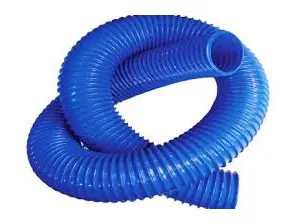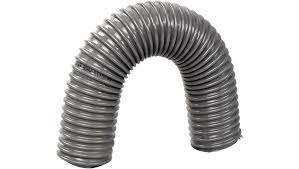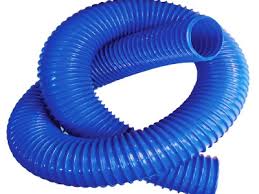Unveiling the Duct Hose
A duct hose is a flexible conduit designed for the efficient transfer of air, gases, liquids, and various materials from one location to another. It is constructed using durable materials like rubber, PVC, or specialized fabrics, making it adaptable to a wide range of applications. Duct hoses are widely used in industries such as HVAC, manufacturing, agriculture, and more. They play a crucial role in maintaining ventilation, controlling dust, and facilitating material handling processes. With their versatility and durability, duct hoses are essential components in various industrial and commercial settings.
Types of Duct Hoses: Tailoring Conduits to Your Needs

In the intricate world of industrial applications, a vital component often remains unsung - the duct hose. This unassuming yet indispensable conduit plays a pivotal role in various sectors, from HVAC systems to manufacturing plants. Its versatility, durability, and adaptability to diverse environments make it a cornerstone of modern engineering.
The Anatomy of a Duct Hose:
In the realm of industrial engineering, the duct hose stands as a crucial conduit, facilitating the flow of various materials and substances. To comprehend its functionality and versatility, it's essential to dissect the intricate anatomy of a duct hose.
1. Inner Liner
At the heart of a duct hose lies the inner liner, a vital element responsible for guiding the material being conveyed. This inner layer is meticulously chosen based on the specific application. It might be composed of rubber for handling abrasive materials or PVC for applications like ventilation, where flexibility and air-tightness are paramount.
2. Reinforcement Layer
Surrounding the inner liner is the reinforcement layer, a critical component that bestows structural integrity and strength to the duct hose. This layer is constructed using materials such as fabric, wire, or composite materials. The choice of reinforcement depends on factors like the intended application, pressure requirements, and the substances being conveyed.
3. Outer Cover
The outer layer serves as a protective shield, safeguarding the duct hose from external elements and environmental factors. It is meticulously crafted from materials like rubber, PVC, or thermoplastic, selected based on the anticipated conditions the hose will face. This outer cover shields the hose from abrasion, weathering, chemical exposure, and other potential sources of wear and damage.
4. End Connections
Duct hoses are equipped with various end connections, which play a pivotal role in facilitating secure attachments to other components or machinery. These connections can take the form of cuffs, flanges, or specialized fittings, ensuring a reliable and leak-proof junction.

Types of Duct Hoses:
Duct hoses, revered for their versatility and adaptability, come in a wide array of types, each engineered to excel in specific applications. Understanding these variations is essential for ensuring the right duct hose is employed for the task at hand.
1. Flexible Ducting
Ideal for applications requiring flexibility and adaptability, flexible ducting is engineered to withstand bending, twisting, and compressing without compromising structural integrity.
- Applications: Ventilation systems, dust collection, material handling, and portable applications where ducts need to be maneuverable.
2. High-Temperature Duct Hoses
Engineered to endure extreme heat, high-temperature duct hoses are indispensable in environments where elevated temperatures are a constant challenge.
- Applications: Furnace ventilation, hot air extraction, exhaust systems in industrial settings, and automotive applications.
3. Chemical Resistant Duct Hoses
Designed to withstand exposure to a wide range of chemicals, these hoses are crucial in industries where corrosive materials are handled.
- Applications: Chemical processing plants, pharmaceutical facilities, wastewater treatment plants, and industries dealing with aggressive substances.
4. Abrasion Resistant Duct Hoses
Constructed to withstand abrasive materials, these hoses are fortified with materials like rubber or fabric to prevent wear and tear.
- Applications: Mining operations, construction sites, material handling in heavy industries, and any environment with abrasive particles.
5. PVC Duct Hoses
Made from polyvinyl chloride, PVC duct hoses are lightweight, cost-effective, and offer excellent resistance to chemicals and weathering.
- Applications: Ventilation and air movement, fume extraction, and light-duty material handling in industries and commercial spaces.
6. Insulated Duct Hoses
These hoses are equipped with insulation layers, providing thermal resistance and ensuring temperature control in both heating and cooling applications.
- Applications: HVAC systems, air conditioning units, and environments where maintaining a consistent temperature is critical.
7. Food Grade Duct Hoses
Manufactured with materials approved for contact with consumable items, food grade duct hoses are crucial in industries that require compliance with food safety regulations.
- Applications: Food processing, beverage production, pharmaceutical industries, and any application where hygiene is paramount.
8. Heavy-Duty Duct Hoses
Engineered for applications that demand robustness and durability, heavy-duty duct hoses are constructed to withstand high pressures and extreme conditions.
- Applications: Construction sites, shipyards, industrial facilities, and applications involving heavy machinery.
Applications of Duct Hoses:
Duct hoses, renowned for their adaptability and reliability, find extensive use across a diverse spectrum of industries. Their versatility makes them indispensable components in a wide range of applications, facilitating processes that are essential for modern society.
1. HVAC Systems
Duct hoses serve as vital conduits in heating, ventilation, and air conditioning (HVAC) systems. They facilitate the efficient transfer of air, ensuring optimal climate control in residential, commercial, and industrial buildings. Whether it's distributing warm or cool air or providing exhaust ventilation, duct hoses are instrumental in maintaining indoor comfort.
2. Manufacturing and Industrial Processes
In manufacturing plants, duct hoses are crucial for a variety of applications. They are used for material handling, conveying dust or debris, and providing ventilation in environments where air quality is a concern. Additionally, duct hoses play a key role in fume extraction systems, ensuring a safe and healthy working environment.
3. Chemical and Petrochemical Industries
Duct hoses designed to resist chemical exposure are indispensable in the chemical and petrochemical sectors. They are employed for the safe transfer of corrosive substances, as well as for ventilation and exhaust systems within facilities dealing with hazardous materials. Their resistance to chemical corrosion is paramount in ensuring safety and operational efficiency.
4. Agriculture and Food Processing
In agricultural settings, duct hoses are used for a range of tasks. They facilitate ventilation in livestock areas, ensuring proper air circulation for the well-being of animals. Duct hoses are also employed for irrigation, conveying grains or feed, and in various processes within food production and processing facilities where compliance with food safety standards is imperative.
5. Automotive and Aerospace Industries
Duct hoses are fundamental components in vehicle systems. In automobiles, they are employed for tasks like air intake, exhaust systems, and ventilation. In aircraft, specialized duct hoses ensure proper ventilation, cooling, and fluid conveyance. Their ability to withstand extreme temperatures and harsh conditions is crucial for reliable operation in these demanding environments.
6. Construction and Mining
In rugged industrial environments like construction sites and mines, duct hoses are indispensable for material handling, dust control, and ventilation. Their durability and resistance to abrasion make them invaluable tools in settings where heavy machinery operates and where the control of airborne particles is essential for worker safety.
7. Marine and Shipbuilding
In maritime applications, duct hoses are used for tasks like ventilation in vessels, controlling engine exhaust, and transporting fluids. Their ability to withstand corrosive marine environments and fluctuating temperatures is critical for their reliability in this sector.
8. Waste Management and Environmental Engineering
Duct hoses play a crucial role in waste management processes, such as material conveyance in recycling facilities and ventilation in waste treatment plants. They aid in maintaining air quality, controlling odors, and ensuring the safe handling of waste materials.
Maintenance and Care of Duct Hoses:
Duct hoses, while robust and versatile, require regular maintenance to ensure they continue to function at their optimal level. Proper care not only extends the lifespan of the hoses but also ensures their efficiency and safety.
1. Regular Inspections
Routine inspections are crucial for identifying early signs of wear, damage, or deterioration. Check for any visible tears, abrasions, or weak spots in the hose material. Pay special attention to areas near end connections and bends, as these are common points of stress.
2. Cleaning
Keeping duct hoses clean is paramount for maintaining their performance. Remove any debris, dust, or contaminants that may have accumulated on the surface. Use a soft brush or cloth to gently clean the exterior, and if necessary, use a mild detergent for more thorough cleaning.
3. Avoiding Overstretching
Avoid excessive stretching or bending of duct hoses, especially if they are not designed for high flexibility. Overstretching can lead to strain on the reinforcement layer, potentially weakening the hose and reducing its lifespan.
4. Proper Storage
When not in use, duct hoses should be stored in a clean, dry area away from direct sunlight. Avoid placing heavy objects on top of the hoses, as this can cause deformation or damage to the material.
5. Avoiding Contact with Sharp Objects
Prevent duct hoses from coming into contact with sharp or abrasive surfaces that could cause punctures or cuts. If the hose is used in an environment with sharp objects, consider implementing protective measures or using an abrasion-resistant hose.
6. Checking End Connections
Regularly inspect end connections, such as cuffs, flanges, or fittings, for signs of wear, corrosion, or leaks. Ensure that connections are secure and free from any damage that could compromise the integrity of the seal.
7. Avoiding Exposure to Harsh Chemicals
If a duct hose is not specifically designed for chemical resistance, avoid exposing it to corrosive or abrasive substances. Chemicals can weaken the material and compromise its structural integrity.
8. Following Manufacturer Guidelines
Adhere to any specific care and maintenance guidelines provided by the manufacturer. These instructions are tailored to the particular type of duct hose and will help ensure it remains in optimal condition.
9. Prompt Repairs
If any damage or wear is identified during inspections, address it promptly. Small repairs or replacements of damaged sections can prevent further deterioration and extend the overall lifespan of the hose.

How to measure a duct hose
- Determine Diameter: The diameter of a duct hose is one of the most critical measurements. Use a tape measure or a caliper tool to measure the internal or external diameter of the hose, depending on your specific requirements.
- For internal diameter: Measure the distance across the inside of the hose.
- For external diameter: Measure the distance across the outside of the hose.
- Measure Length: Determine the length of the hose you need. Uncoil or stretch out the hose and use a tape measure to measure from one end to the other. If you require a specific length, be sure to measure accurately.
- Consider the End Connections: If your duct hose has end connections (cuffs, flanges, etc.), take note of their dimensions as well. These will be important for ensuring a proper fit with your existing equipment or system.
- Account for Flexibility or Expansion: If your duct hose is flexible or designed to expand and contract, consider this when measuring. Allow for any potential changes in length when the hose is in use.
- Note Any Special Features: If the duct hose has any special features, such as insulation, special linings, or reinforcement layers, take note of these as they may affect the fit and performance.
- Consider Application Requirements: Depending on the application, you may need to measure additional factors such as wall thickness, pitch (if corrugated), or any specific features required for compatibility with your system.
- Refer to Manufacturer Guidelines: If you are uncertain about how to measure a specific type of duct hose, refer to the manufacturer's guidelines or specifications. They may provide specific instructions for measuring that particular type of hose.
various materials for duct hose
- PVC (Polyvinyl Chloride):
- Properties: PVC duct hoses are lightweight, flexible, and cost-effective. They offer good resistance to chemicals, weathering, and abrasion.
- Applications: Ventilation systems, air movement, fume extraction, and light-duty material handling.
- Rubber:
- Properties: Rubber duct hoses are durable, flexible, and resistant to abrasion. They offer good thermal resistance and can withstand exposure to chemicals and moisture.
- Applications: Material handling, air intake and exhaust systems, and applications requiring flexibility and durability.
- Neoprene:
- Properties: Neoprene duct hoses are known for their excellent resistance to heat, oil, and chemicals. They are also highly flexible and durable.
- Applications: HVAC systems, automotive applications, and environments with exposure to oils and solvents.
- Polyurethane:
- Properties: Polyurethane duct hoses are characterized by their high flexibility, abrasion resistance, and resistance to chemicals and oils.
- Applications: Material handling, dust collection, and applications requiring flexibility and durability.
- Silicone:
- Properties: Silicone duct hoses have a wide temperature range, excellent flexibility, and resistance to high temperatures, UV radiation, and chemicals.
- Applications: High-temperature environments, exhaust systems, and applications involving extreme temperature fluctuations.
- Fiberglass Fabric:
- Properties: Fiberglass fabric is often used as a reinforcement layer in duct hoses. It provides excellent strength, durability, and resistance to high temperatures.
- Applications: High-temperature environments, exhaust systems, and applications requiring extra reinforcement.
- Metal:
- Properties: Metal duct hoses are constructed using metal sheets or strips. They offer high durability, fire resistance, and are suitable for applications requiring rigidity.
- Applications: Industrial ventilation, hot air transfer, and applications involving high temperatures or corrosive environments.
- Thermoplastic Elastomers (TPE):
- Properties: TPE duct hoses combine the flexibility of rubber with the processability of plastic. They offer good resistance to chemicals and abrasion.
- Applications: HVAC systems, material handling, and applications requiring flexibility and durability.
- Nylon:
- Properties: Nylon duct hoses are lightweight, durable, and resistant to abrasion. They offer good flexibility and are often used in applications where weight is a consideration.
- Applications: Material handling, dust collection, and applications requiring lightweight and durable hoses.
How to install a duct hose
Materials Needed:
- Duct hose
- End connections (cuffs, flanges, etc., if applicable)
- Clamps or fasteners (for securing the hose)
Steps:
- Prepare the Surfaces:
- Ensure that both ends where the duct hose will be attached are clean and free of debris. This will promote a secure seal.
- Cutting and Sizing:
- Measure and cut the duct hose to the desired length using a sharp knife or scissors. It's crucial to have an accurate measurement to avoid unnecessary slack or tension.
- Attaching End Connections (if applicable):
- If your duct hose has end connections (cuffs, flanges, etc.), attach them securely to the ends of the hose. This will provide a stable connection point.
- Securing with Clamps:
- Slide clamps over the end of the hose, ensuring they are positioned over the end connection (if present) and extending onto the surface it will be connected to. This will help secure the hose in place.
- Connecting to Ventilation System:
- Position one end of the duct hose over the appropriate outlet or opening in the ventilation system. Make sure it fits snugly and aligns properly.
- Securing the Hose:
- Tighten the clamps to secure the hose in place. Ensure that they are tightened adequately to prevent any air leakage or disconnection.
- Attaching to Equipment or Machinery (if applicable):
- If the other end of the duct hose needs to be connected to specific equipment or machinery, repeat steps 4 and 5 to secure it in place.
- Inspecting the Installation:
- Once the duct hose is installed, visually inspect the connections to ensure they are secure and there are no visible gaps or leaks.
- Testing the System (if applicable):
- Turn on the ventilation system (or any associated equipment) to ensure that air or materials are flowing through the duct hose as intended. Check for any unusual sounds or signs of leakage.
- Making Adjustments (if necessary):
- If you notice any issues during testing, make the necessary adjustments to the installation. This may involve tightening clamps, repositioning the hose, or checking end connections.
The duct hose, a seemingly unremarkable component, emerges as a linchpin in various industries, enabling processes that underpin modern civilization. Its diverse types cater to specific needs, from withstanding extreme temperatures to resisting corrosive chemicals. With proper care and attention to maintenance, duct hoses can continue to serve as reliable conduits, illustrating their enduring importance in the tapestry of industrial progress. As industries evolve, the duct hose remains an unsung hero, quietly enabling progress in diverse sectors around the globe.



